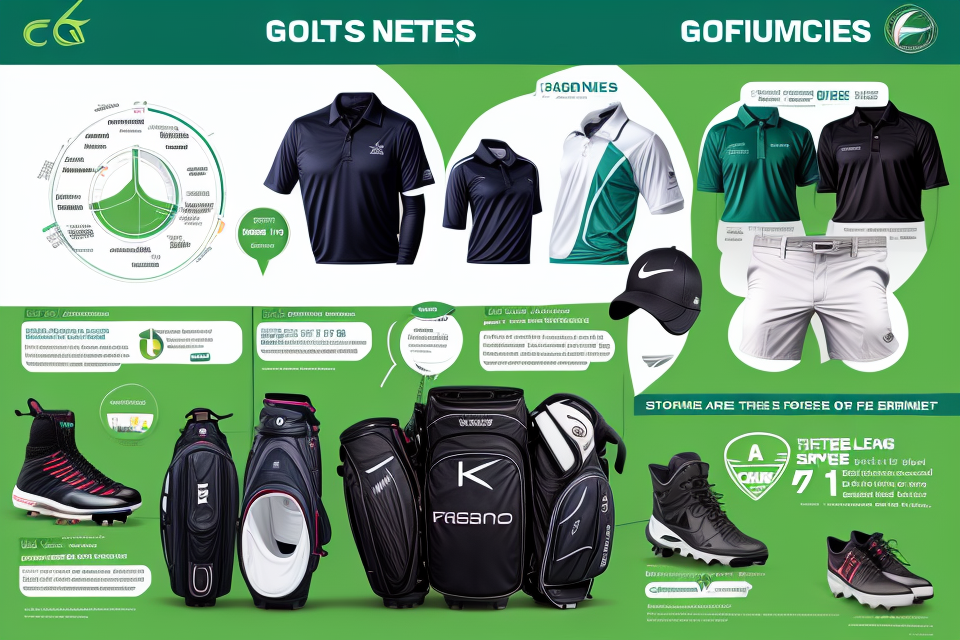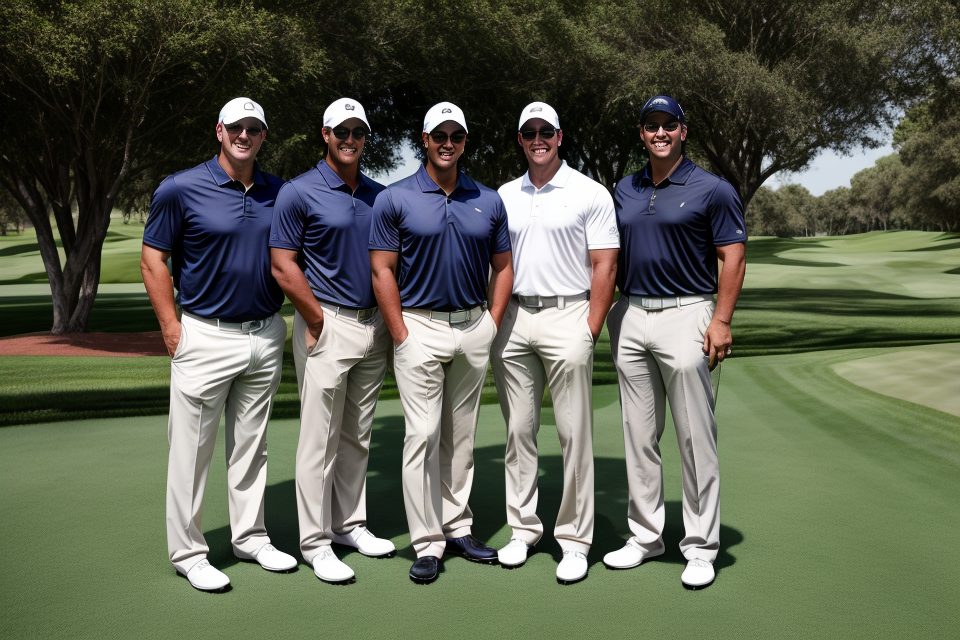
Golf is one of the most popular sports in the world, with millions of players and fans worldwide. The sport is known for its elegance and sophistication, and it is no surprise that the golf apparel industry has grown significantly over the years. From polo shirts to golf pants, golf apparel has become a staple in the fashion industry. But just how big is the golf apparel industry? In this comprehensive analysis, we will take a closer look at the size and scope of the golf apparel market, its growth trajectory, and the factors that have contributed to its success. Whether you are a fan of the sport or simply interested in fashion, this analysis will provide valuable insights into the world of golf apparel.
The Size and Scope of the Golf Apparel Market
Golf Apparel Sales Revenue Worldwide
The golf apparel industry is a significant contributor to the global sportswear market, with sales revenue worldwide estimated to reach billions of dollars annually. In this section, we will take a closer look at the golf apparel sales revenue in four key regions: the United States, Europe, Asia Pacific, and the Rest of the World.
United States
The United States is the largest market for golf apparel, with an estimated sales revenue of around $2.5 billion in 2021. The country’s large population and strong interest in golf have helped to drive the growth of the golf apparel market. The demand for high-quality golf apparel and accessories has increased in recent years, with many golfers seeking performance-enhancing and stylish clothing that meets their needs both on and off the course.
Europe
Europe is the second-largest market for golf apparel, with an estimated sales revenue of around $1.5 billion in 2021. The region has a long history of golf, and its golf apparel market is driven by a large number of avid golfers and a strong appreciation for high-quality golf clothing. The United Kingdom is the largest market for golf apparel in Europe, accounting for a significant portion of the region’s sales revenue.
Asia Pacific
The Asia Pacific region is the fastest-growing market for golf apparel, with an estimated sales revenue of around $1 billion in 2021. The growth of the golf apparel market in the region is driven by the increasing popularity of golf as a sport and the rising disposable income of middle-class consumers. China is the largest market for golf apparel in the Asia Pacific region, with a growing number of golf courses and a large population of golf enthusiasts.
Rest of the World
The Rest of the World category includes countries such as Canada, Australia, and South Africa, among others. The golf apparel market in these countries is relatively small compared to the United States, Europe, and Asia Pacific, with an estimated sales revenue of around $500 million in 2021. However, the market is growing, driven by an increasing interest in golf and a growing awareness of the importance of high-quality golf apparel.
In conclusion, the golf apparel industry is a significant contributor to the global sportswear market, with sales revenue worldwide estimated to reach billions of dollars annually. The industry is driven by a large number of avid golfers who seek high-quality and stylish clothing that meets their needs both on and off the course. The United States is the largest market for golf apparel, followed by Europe and the Asia Pacific region. The Rest of the World category includes countries such as Canada, Australia, and South Africa, among others, and is growing due to an increasing interest in golf and a growing awareness of the importance of high-quality golf apparel.
Market Share of Key Players
Top Golf Apparel Manufacturers
The golf apparel industry is dominated by a few key players who control a significant portion of the market share. The following are some of the top golf apparel manufacturers:
- Nike: Nike is a global leader in the sports apparel industry and has a strong presence in the golf apparel market. The company offers a wide range of golf apparel, including golf shoes, golf clothing, and golf accessories.
- Adidas: Adidas is another major player in the golf apparel industry. The company offers a range of golf shoes, golf clothing, and golf accessories, and has a strong brand image among golf enthusiasts.
- Under Armour: Under Armour is a well-known brand in the sports apparel industry and has been expanding its presence in the golf apparel market in recent years. The company offers a range of golf apparel, including golf shoes, golf clothing, and golf accessories.
- Puma: Puma is a global sports brand that has a strong presence in the golf apparel market. The company offers a range of golf shoes, golf clothing, and golf accessories, and has a loyal customer base among golf enthusiasts.
- Titleist: Titleist is a leading golf equipment manufacturer that also offers a range of golf apparel. The company is known for its high-quality golf apparel, including golf shoes, golf clothing, and golf accessories.
Market Trends and Consolidation
The golf apparel industry is experiencing significant market trends and consolidation. One of the major trends is the increasing demand for golf apparel that is both functional and fashionable. This has led to a rise in the popularity of golf apparel made from technical fabrics that offer superior performance and comfort.
Another trend in the golf apparel industry is the growing focus on sustainability and environmental responsibility. Many golf apparel manufacturers are now incorporating eco-friendly materials and production methods into their products, in response to growing consumer demand for sustainable and environmentally responsible products.
The golf apparel industry is also experiencing consolidation, with some of the larger players acquiring smaller brands to expand their product offerings and market share. This consolidation is driven by the desire to increase efficiency and scale, as well as to expand into new markets and product categories.
Overall, the golf apparel industry is a dynamic and competitive market, with a range of key players vying for market share. The industry is driven by changing consumer preferences and market trends, and is expected to continue to grow in the coming years.
Segmentation of the Golf Apparel Market
Apparel Type
The golf apparel market can be segmented based on the type of apparel, which includes clothing items such as golf shirts, pants, shorts, skirts, and dresses. Each of these apparel types has its own unique characteristics and is designed to meet the specific needs of golfers. For example, golf shirts are typically made of lightweight, breathable fabrics that allow for a full range of motion, while pants and shorts are designed to be comfortable and flexible for a golf swing.
Gender
Another way to segment the golf apparel market is by gender. Men’s and women’s golf apparel are distinct categories, with different styles, fits, and features. Men’s golf apparel often emphasizes functionality and durability, while women’s golf apparel tends to prioritize fashion and comfort. Some companies also offer unisex golf apparel that can be worn by both men and women.
Age Group
The golf apparel market can also be segmented by age group, with different products designed for various age ranges. Younger golfers may prefer more casual, sporty styles, while older golfers may prefer more traditional, formal attire. Some companies offer age-specific golf apparel lines that cater to the unique needs and preferences of different age groups.
Distribution Channel
Finally, the golf apparel market can be segmented by distribution channel, which includes online retail, brick-and-mortar stores, and golf resorts and courses. Online retail has become increasingly popular in recent years, offering convenience and a wider selection of products. Brick-and-mortar stores provide a more personal shopping experience, with knowledgeable staff and the ability to try on clothes before purchasing. Golf resorts and courses often have pro shops that sell golf apparel and equipment.
The Growth Drivers of the Golf Apparel Industry
Increasing Popularity of Golf as a Sport
Golf has experienced a significant rise in popularity over the past few decades, becoming a sport that is enjoyed by millions of people worldwide. This increase in popularity has been driven by a number of factors, including the growth of the sport in developing countries, the success of golf tour events, and the influence of celebrity endorsements.
Golf’s Growing Global Appeal
One of the key drivers of the increasing popularity of golf is its growing global appeal. The sport has traditionally been popular in countries such as the United States, Scotland, and Australia, but it has now spread to other parts of the world, including Asia, Africa, and South America. This has been driven by a number of factors, including the growth of the middle class in developing countries, which has led to an increase in leisure spending, and the rise of golf-specific media and marketing campaigns that have helped to raise the profile of the sport.
Golf Tour Events and Sponsorships
Another key driver of the increasing popularity of golf is the success of golf tour events and sponsorships. Golf tour events such as the Masters, the US Open, and the British Open attract millions of viewers from around the world, and they are a major source of revenue for the sport. In addition, major sponsors such as Nike, Adidas, and Under Armour have helped to raise the profile of the sport by investing in golf-specific marketing campaigns and athlete endorsements.
Celebrity Endorsements and Influence
Finally, the influence of celebrity endorsements has also played a key role in the increasing popularity of golf. Golfers such as Tiger Woods, Rory McIlroy, and Justin Rose have become global sports icons, and their endorsements of golf-specific brands and products have helped to raise the profile of the sport. In addition, the success of golf-specific media platforms such as the Golf Channel and Sky Sports has helped to create a greater awareness of the sport and its major events.
Overall, the increasing popularity of golf as a sport has been driven by a number of factors, including its growing global appeal, the success of golf tour events and sponsorships, and the influence of celebrity endorsements. As a result, the golf apparel industry has seen significant growth in recent years, and it is expected to continue to grow in the future.
Technological Advancements in Golf Apparel
Material Science and Performance Enhancement
In recent years, there has been a significant push towards using advanced materials in golf apparel. This has led to the development of fabrics that are not only more comfortable but also more durable and resistant to wear and tear. For example, some manufacturers have started to use moisture-wicking materials that can help keep golfers cool and dry during their rounds. Others have developed fabrics that are specifically designed to provide better flexibility and range of motion, allowing golfers to swing freely without restriction.
Smart Textiles and Wearable Technology
Another area where technology has had a major impact on golf apparel is in the development of smart textiles and wearable technology. These innovations have allowed manufacturers to create garments that can track and analyze a golfer’s performance, providing valuable insights into their swing mechanics and other key metrics. For example, some companies have developed golf shirts that incorporate sensors that can monitor a golfer’s heart rate, distance traveled, and other biometric data during their round. Other manufacturers have developed smart golf gloves that can provide real-time feedback on a golfer’s grip pressure and other key factors that can affect their swing.
Overall, the integration of technology into golf apparel has helped to drive growth in the industry by providing new and innovative products that appeal to a wide range of golfers. As technology continues to advance, it is likely that we will see even more exciting developments in the world of golf apparel, making it an increasingly important and dynamic sector of the broader golf industry.
The Impact of Sustainability and Environmental Consciousness
Eco-Friendly Production Practices
The golf apparel industry has seen a growing trend towards sustainability and environmental consciousness in recent years. This shift is reflected in the production practices of companies within the industry. Many golf apparel brands are now adopting eco-friendly production methods to reduce their environmental impact. These practices include using sustainable materials, reducing water and energy consumption, and minimizing waste during the manufacturing process. Some companies have also implemented programs to offset their carbon emissions and support reforestation efforts.
Consumer Demand for Sustainable Products
In addition to the actions taken by companies, consumer demand for sustainable products has also played a significant role in driving the trend towards sustainability in the golf apparel industry. Consumers are becoming increasingly aware of the environmental impact of their purchases and are looking for products that are made with sustainable materials and produced in an environmentally responsible manner. This demand has led many golf apparel brands to prioritize sustainability in their production processes and to market their products as environmentally friendly.
As a result of these factors, the golf apparel industry has seen a growing trend towards sustainability and environmental consciousness. This trend is likely to continue in the future as consumers become more aware of the environmental impact of their purchases and as companies adopt more sustainable production practices.
The Challenges Facing the Golf Apparel Industry
Intense Competition and Market Saturation
Price Wars and Margin Pressure
The golf apparel industry is highly competitive, with numerous brands vying for market share. This intense competition has led to a situation where companies are forced to compete on price, resulting in margin pressure. To remain competitive, brands are forced to reduce their prices, which in turn reduces their profit margins. This situation is further exacerbated by the high cost of marketing and advertising, which further erodes profitability.
Difficulty in Differentiating Products
Another challenge facing the golf apparel industry is the difficulty in differentiating products. With so many brands offering similar products, it becomes increasingly difficult for companies to differentiate themselves from their competitors. This situation is further compounded by the fact that many consumers are loyal to specific brands, making it difficult for new brands to gain a foothold in the market. As a result, companies are forced to invest heavily in marketing and advertising to try and differentiate themselves from their competitors.
However, even with these challenges, the golf apparel industry remains a significant player in the broader apparel industry. Despite the intense competition and market saturation, there is still room for growth and innovation. Brands that are able to differentiate themselves through unique product offerings, innovative marketing strategies, and exceptional customer service are likely to succeed in this highly competitive industry.
Regulatory and Environmental Factors
Labor Standards and Working Conditions
One of the significant challenges facing the golf apparel industry is labor standards and working conditions. Many manufacturers of golf apparel operate in countries where labor laws are not strictly enforced, and workers are often subjected to poor working conditions. In some cases, workers are not paid a living wage, and they work long hours in dangerous and unhealthy environments.
Additionally, the industry is under pressure to improve working conditions, including providing better wages and benefits, and ensuring that workers are treated fairly and with respect. Many consumers are becoming more aware of the social and environmental impact of the products they purchase, and they are demanding that companies be more transparent about their supply chains and labor practices.
Environmental Regulations and Sustainability Standards
Another challenge facing the golf apparel industry is environmental regulations and sustainability standards. The production of golf apparel requires significant amounts of water, energy, and raw materials, which can have a negative impact on the environment. In addition, the industry generates a significant amount of waste, including fabric scraps, packaging materials, and plastic garment bags.
To address these issues, many golf apparel manufacturers are working to improve their sustainability practices. This includes using more environmentally friendly materials, reducing water and energy usage, and implementing recycling programs to reduce waste.
However, there are still many challenges to overcome. For example, some materials, such as polyester and nylon, are not biodegradable and can take hundreds of years to decompose. In addition, the industry is still heavily reliant on fossil fuels for energy, which contributes to greenhouse gas emissions and climate change.
Overall, the golf apparel industry faces significant challenges related to labor standards and working conditions, as well as environmental regulations and sustainability standards. To remain competitive and meet the demands of consumers, manufacturers must work to improve their practices and find ways to reduce their environmental impact while ensuring that workers are treated fairly and with respect.
The Future of the Golf Apparel Industry
Emerging Trends and Opportunities
Growth in Golf Tourism and Travel
Golf tourism and travel is a rapidly growing industry, with more and more people choosing to combine their love of golf with travel. This trend is driving demand for golf apparel, as travelers look for functional and stylish clothing that can be worn both on and off the course. Golf resorts and courses are also investing in new facilities and services to attract golfers, creating additional opportunities for golf apparel brands to showcase their products.
Increased Focus on Health and Wellness
The health and wellness trend is having a significant impact on the golf apparel industry. As more people prioritize healthy lifestyles, there is a growing demand for apparel that is both functional and fashionable. Golf apparel brands are responding to this trend by incorporating features such as moisture-wicking fabrics, stretch materials, and compression technology into their designs. This not only improves the performance of the clothing but also appeals to the health-conscious consumer.
Personalization and Customization
Personalization and customization are becoming increasingly important in the golf apparel industry. Consumers are looking for unique and personalized products that reflect their individual style and preferences. Golf apparel brands are responding to this trend by offering custom-fit garments, made-to-measure services, and the ability to customize colors and designs. This not only enhances the customer experience but also creates a competitive advantage for brands that can offer personalized products. Additionally, the rise of e-commerce and online retailers has made it easier for consumers to access customization options, further fueling the demand for personalized golf apparel.
Potential Threats and Challenges
Economic Uncertainty and Market Fluctuations
The golf apparel industry, like any other sector, is not immune to economic uncertainty and market fluctuations. Economic downturns can lead to a decline in consumer spending, which can negatively impact the sales of golf apparel. Moreover, fluctuations in foreign exchange rates can affect the costs of raw materials and manufacturing, ultimately affecting the pricing and profitability of golf apparel products.
Disruptive Technologies and New Market Entrants
The golf apparel industry is also facing potential threats and challenges from disruptive technologies and new market entrants. E-commerce platforms have disrupted traditional retail channels, enabling consumers to purchase golf apparel online at competitive prices. Additionally, advancements in sports technology have led to the development of new fabrics and materials that can enhance the performance of golf apparel. As a result, established brands may face increased competition from new market entrants that leverage these technologies to create innovative and performance-enhancing golf apparel products.
Ethical and Reputational Risks
Ethical and reputational risks are also emerging as potential threats and challenges for the golf apparel industry. Consumers are becoming increasingly conscious of the environmental and social impact of their purchases, and are demanding more sustainable and ethical products. The golf apparel industry is no exception, and brands that fail to address these concerns may face reputational risks and potential boycotts from environmentally and socially conscious consumers. Moreover, labor abuses and unethical practices in the supply chain can also tarnish the reputation of golf apparel brands, leading to loss of consumer trust and sales. Therefore, it is essential for golf apparel brands to prioritize ethical and sustainable practices in their operations to mitigate these risks and ensure long-term success in the industry.
Strategies for Success in the Golf Apparel Industry
Diversification and Risk Management
Diversification is a key strategy for success in the golf apparel industry. By diversifying their product offerings, companies can reduce their reliance on any one particular product or market segment, which can help to mitigate risk and increase their overall stability. For example, companies may choose to expand into related markets such as golf equipment or accessories, or they may offer a wider range of products in the apparel category, such as shoes, hats, and bags. Additionally, risk management strategies such as hedging and insurance can help companies to mitigate the risks associated with fluctuations in demand, supply chain disruptions, and other uncertainties.
Innovation and Design
Innovation and design are also critical strategies for success in the golf apparel industry. Companies that are able to consistently introduce new and innovative products that meet the changing needs and preferences of consumers are likely to be more successful in the market. This may involve developing new fabrics, incorporating advanced materials, or incorporating cutting-edge design features. Additionally, companies that are able to create products that are both functional and fashionable are likely to be more successful in the market.
Strong Branding and Marketing
Finally, strong branding and marketing are essential for success in the golf apparel industry. Companies that are able to create a strong brand identity and effectively communicate their value proposition to consumers are likely to be more successful in the market. This may involve developing a unique brand personality, creating compelling marketing campaigns, and building strong relationships with retailers and other industry partners. Additionally, companies that are able to leverage digital marketing channels such as social media and e-commerce are likely to be better positioned to reach and engage with consumers.
FAQs
1. What is the golf apparel industry?
The golf apparel industry refers to the market for clothing and accessories designed for golfers. This includes everything from golf shirts and pants to hats and gloves.
2. How big is the golf apparel industry?
The golf apparel industry is a significant market, with estimated global revenue of over $10 billion.
3. What factors contribute to the growth of the golf apparel industry?
The golf apparel industry has grown in recent years due to a number of factors, including an increase in the number of golfers worldwide, a growing interest in golf-related fashion, and the rise of online retail.
4. Who are the key players in the golf apparel industry?
The golf apparel industry is dominated by a few large companies, including Nike, Adidas, and Under Armour. However, there are also many smaller brands and independent designers who are making a name for themselves in the industry.
5. What are the most popular types of golf apparel?
The most popular types of golf apparel include golf shirts, pants, shorts, skirts, and hats. Many golfers also wear specialized footwear designed for the sport.
6. How does the golf apparel industry differ from other apparel industries?
The golf apparel industry is unique in that it is specifically tailored to the needs of golfers. Golfers have different requirements for their clothing than other athletes, and the golf apparel industry is designed to meet those needs.
7. What are the challenges facing the golf apparel industry?
The golf apparel industry faces a number of challenges, including increasing competition from other sports and leisure activities, changing consumer preferences, and fluctuations in the global economy.
8. What is the future outlook for the golf apparel industry?
The future outlook for the golf apparel industry is positive, with continued growth expected in the coming years. However, the industry will need to adapt to changing consumer preferences and stay ahead of emerging trends in order to remain successful.


